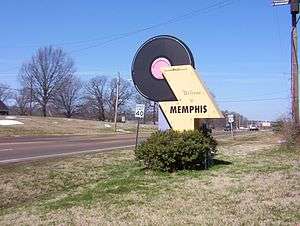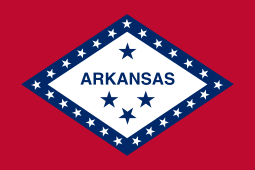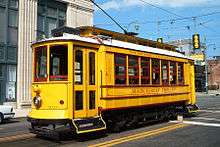St. Mary's Episcopal Cathedral (Memphis, Tennessee)
| St. Mary's Episcopal Cathedral | |
|---|---|
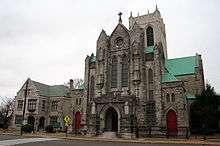 Diocesan House, Cathedral, and Sisters' Chapel | |
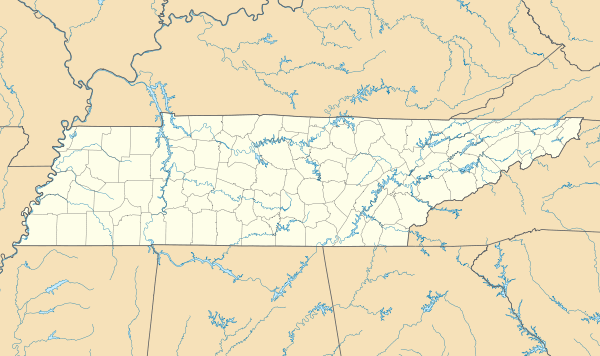 St. Mary's Episcopal Cathedral | |
| 35°8′48.2″N 90°2′12.56″W / 35.146722°N 90.0368222°WCoordinates: 35°8′48.2″N 90°2′12.56″W / 35.146722°N 90.0368222°W | |
| Location |
700 Poplar Avenue Memphis, Tennessee |
| Country | United States |
| Denomination | Episcopal Church |
| Website |
stmarysmemphis |
| History | |
| Founded | 1858 (parish) |
| Consecrated | 1871 |
| Architecture | |
| Status | Cathedral |
| Functional status | Active |
| Architect(s) | William Halsey Wood (original plans), L.M. Weathers, and Bayard Snowden Cairns |
| Style |
Late Gothic Revival (Early English period) |
| Completed |
1898 (crypt) 1907 (west front and nave) 1926 (tower, transepts, chancel) |
| Administration | |
| Diocese | West Tennessee |
| Province | IV (Southeast) |
| Clergy | |
| Bishop(s) | Don E. Johnson |
| Dean | Andy Andrews[1] |
| Canon(s) | Laura F. Gettys |
| Deacon(s) | Drew Woodruff |
| Laity | |
| Director of music | Dennis Janzer |
St. Mary's Episcopal Cathedral, located near downtown Memphis, Tennessee, is the cathedral church of the Episcopal Diocese of West Tennessee and the former cathedral of the old statewide Episcopal Diocese of Tennessee.
History
St. Mary's was founded as a "North Memphis" mission chapel by the Ladies' Educational and Missionary Society of Calvary Church (the city's first Episcopal parish) with oversight from Calvary's rector, Charles Quintard, who later became the second bishop of the Diocese of Tennessee. Quintard led the chapel's first service on Thanksgiving Day, November 26, 1857.[2] An item in the Memphis Appeal, dated November 29, describes the occasion:
The Mission Church on Poplar Street. This Church which has been erected by the pious zeal of the ladies belonging to the Episcopal Church of this city was organized Thanksgiving Day by the election of wardens and vestrymen. The Church is called St. Mary's, and the Reverend Richard Hines has been chosen rector. Mr. Hines has arrived in the city and will preach at St. Mary's this morning. The seats are all free, the expenses of the Church are defrayed by the offering of the congregation.
Unlike its mother church, Calvary, this new parish would not have designated family pews or charge rent for them, enabling less affluent Memphians to regularly attend Episcopal services for the first time.
|
Sisters' Chapel and St. Mary's School, 1900 | |
| Monastery information | |
|---|---|
| Other names | St. Mary's School for Girls, Church Home |
| Order | Community of St. Mary (Episcopal) founded in New York, NY, 1865 as the "Sisterhood of St. Mary" |
| Established | 1873, at request of Bishop Charles Quintard |
| Disestablished | 1910, when the sisters formally moved to St. Mary's on the Mountain Convent, Sewanee, Tennessee |
| Mother house | Mount St. Gabriel Convent, Peerskill, New York |
| Diocese | Episcopal Diocese of Tennessee |
| People | |
| Founder(s) | Sister Constance, superior at Memphis; Sister Harriet, founder and mother superior, Sisterhood of St. Mary |
| Important associated figures | Constance and her Companions (yellow fever martyrs listed in the Episcopal Calendar of Saints) |
| Site | |
| Location | On the close of St. Mary's Cathedral, Memphis, Tennessee |
| Visible remains | Sisters' Chapel (on the cathedral close), group grave marker of yellow fever martyrs at Elmwood Cemetery |
St. Mary's was officially consecrated as a parish church on Ascension Day, May 13, 1858, by the Rt. Rev. James Hervey Otey, the first Bishop of Tennessee, with assistance from the rectors of Calvary and Grace (Memphis), St. Luke's (Jackson), St. Mary's (Covington), St. James (Bolivar), and by the new parish's own rector, Richard Hines, who would remain there until 1871.
First Episcopal cathedral in the South (1871)
Thirteen years after its founding, St. Mary's became the first Episcopal cathedral in the American South.[3] While the 1866 Journal of the Proceedings of the Diocese of Tennessee's 34th convention and the national Episcopal Church's 1868 Journal of the General Convention both list St. Mary's as a cathedral church, the official transition from parish to "bishop's church" was January 1, 1871.
At the time, only a handful of Episcopal dioceses had adopted the English-style cathedral system, mostly in the Midwest and the western frontier, where semi-itinerant bishops required more tangible ecclesiastical bases from which to administer sparse, but expansive, new dioceses and missionary territories. While the Episcopal Church was once a part of the Church of England, the American dioceses were slow to designate official cathedrals in keeping with the Protestant or Reformed character of its members. But as the Oxford Movement's “high church” or Roman Catholic-style liturgy began to take root in the United States, Episcopal cathedrals began to appear. With a devoted high churchman as its bishop (Quintard), the Diocese of Tennessee became an early adopter of this trend.
Martyrs and the cathedral
St. Mary's Episcopal Cathedral is closely associated with two episodes of self-sacrifice or martyrdom known throughout the world. Both episodes dramatically reduced the size of St. Mary's congregation, either through death or controversy.
Constance and her companions
Memphis suffered periodic epidemics of yellow fever, a mosquito-borne hemorrhagic viral infection (related to dengue fever and Ebola) throughout the 19th century. The worst of the epidemics occurred in the summer of 1878, when 5,150 Memphians died and the fast-growing city lost its charter due to depopulation. Five years earlier, a group of Episcopal nuns from the recently formed Sisters of St. Mary (now the Community of St. Mary) were invited by Bishop Quintard to take over operation of the St. Mary's School for Girls, now called St. Mary's Episcopal School, which had been relocated to the cathedral site.[4] When the 1878 epidemic struck, a number of priests and nuns (both Protestant and Catholic), doctors—and even a bordello owner, Annie Cook—stayed behind to tend to the sick and dying, despite the high risk of contracting the disease, which often resulted in a painful death. The Episcopal nuns' superior, Sister Constance, three other Episcopal nuns, and two Episcopal priests are known throughout the Anglican Communion as "Constance and Her Companions" or, informally, the "Martyrs of Memphis". Added to the Episcopal Church's Lesser Feasts and Fasts in 1981, their feast day (September 9) commemorates their sacrifices.
A traditional Anglican prayer memorializes the martyrs in this way:
We give thee thanks and praise, O God of compassion, for the Heroic witness of Constance and her companions, who, in a time of plague and pestilence, were steadfast in their care for the sick and the dying, and loved not their own lives, even unto death. Inspire in us a like love and commitment to those in need, following the example of our Savior Jesus Christ...
- Episcopal nuns and priests who died from the epidemic
- Sister Constance (née Caroline Louise Darling, born Medway, Massachusetts, 1846), superior of the work at Memphis, headmistress of St. Mary’s School for Girls.
- Sister Thecla, sacristan of St. Mary’s Cathedral and its school chapel, instructor in music and grammar (English and Latin)
- Sister Ruth, nurse at Trinity Infirmary, New York
- Sister Frances, a newly professed nun given charge of the Church Home orphanage
- The Rev. Charles Carroll Parsons, rector of Grace Church, Memphis; former U.S. Army artillery commander, West Point alumnus and professor; served with classmate Lt. Col. George Armstrong Custer in Kansas, defense counsel in Custer's 1867 court-martial trial.
- The Rev. Louis S. Schuyler, newly ordained assistant rector at Parsons' prior parish, Holy Innocents Episcopal Church, Hoboken, New Jersey
Martin Luther King, Jr.

The second historic/tragic event that St. Mary's Cathedral attempted to mitigate was the 1968 assassination of Martin Luther King, Jr. The day after King's death, Memphis clergy from many churches and synagogues met at the cathedral. In an impromptu move, Dean William Dimmick (later Bishop of Northern Michigan and co-author of certain rites in the 1979 Book of Common Prayer) took up the cathedral's processional cross and led the assembled ministers down Poplar Avenue to City Hall to petition Mayor Henry C. Loeb to end the labor standoff that King was in town to help negotiate. (The sanitation workers were protesting unsafe conditions, abusive white supervisors, low wages and the city government's refusal to recognize their union). Nearly half of the cathedral's membership eventually left in protest of Dimmick's gesture of racial unity.
Like Constance and her companions, King was added to the Episcopal Church's Calendar of Saints, where he is venerated on January 15. Elsewhere in the Anglican Communion, King is memorialized with a statue over the western entrance of Westminster Abbey, along with nine other 20th-century martyrs.
"New" cathedral building
Construction of its present Gothic Revival structure began in 1898 and was completed in 1926, when the parenthetical phrase "(Gailor Memorial)" was appended to the cathedral's formal name in honor of the Rt. Rev. Thomas Frank Gailor, Bishop of Tennessee and president of the National Council of the Episcopal Church.
Diocese of West Tennessee
The Episcopal Diocese of Tennessee spanned the entire state until 1982, when it began a long-considered partition based on the State of Tennessee's three Grand Divisions. The Episcopal Diocese of West Tennessee was created in 1982, with St. Mary's retained as its cathedral church. The Continuing Diocese of Tennessee was again split in 1985 when the Episcopal Diocese of East Tennessee was formed.[5]
Each of the three realigned dioceses retained an important legacy of the old statewide body: West Tennessee had St. Mary's Cathedral; the diocese in Middle Tennessee retained the name "Diocese of Tennessee" and the status as the Episcopal Church's sixteenth diocese; and the East Tennessee diocese welcomed Bishop William Evan Sanders, eighth bishop of Tennessee, as its own first bishop. (Sanders served as the dean of St. Mary's from 1947 until 1961, when he became bishop coadjutor and moved to Knoxville to help manage the statewide diocese's work in East Tennessee.)
Ironically, while St. Mary's was the South's first Episcopal cathedral, Tennessee's other two cathedrals, Christ Church (Nashville) and St. John's in Knoxville are both older parishes, having been organized in 1829 with the original formation of the Diocese of Tennessee.
Historic and contemporary images
 Dr. Richard Hines, first rector, 1857-1871
Dr. Richard Hines, first rector, 1857-1871 Deacon Carol Gardner and Bishop Don Johnson in Easter procession 2007
Deacon Carol Gardner and Bishop Don Johnson in Easter procession 2007- Displayed in the north transept, this stone is part of one of the columns of the balustrade that surrounded the ancient Pool of Bethesda. Brought from Jerusalem by Bishop Thomas F. Gailor, June 1, 1928.
- "Sisters of St. Mary Window"
 Original cathedral building c. 1898
Original cathedral building c. 1898 Sister's Chapel and St. Mary's School for Girls, c. 1900
Sister's Chapel and St. Mary's School for Girls, c. 1900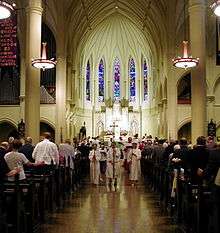 Recession after service
Recession after service- cross-section view
- Interior view of West Front door
- "West" front interior
 Altar with cross enshrouded for Lent
Altar with cross enshrouded for Lent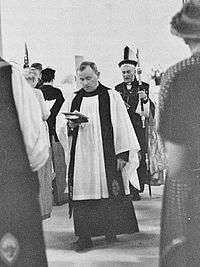 Dean William A. Dimmick 1960
Dean William A. Dimmick 1960 "Saint on break" in Sisters' Chapel
"Saint on break" in Sisters' Chapel- Detail from the "Baptism Window"
 Cathedral Guild Lunches 1906
Cathedral Guild Lunches 1906 Sisters' Chapel (1888) is the oldest structure in the Cathedral complex.
Sisters' Chapel (1888) is the oldest structure in the Cathedral complex.- The cathedral itself is flanked on the left by the Diocesan House and on the right by the Sisters' Chapel.
 Glastonbury Abbey stone
Glastonbury Abbey stone Cathedral construction bond
Cathedral construction bond- Mary and Jesus
- Parish Hall, built on the site of the Cloister Garden
_of_the_Episcopal_Diocese_of_West_Tennessee.jpg) Cathedra (bishop's seat)
Cathedra (bishop's seat)- looking east across nave
- "South" transept windows
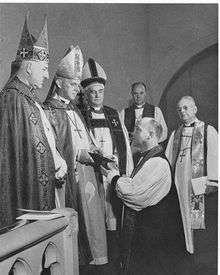 In 1962 Dean Sanders was consecrated as "Bishop Coadjutor Sanders," Diocese of Tennessee
In 1962 Dean Sanders was consecrated as "Bishop Coadjutor Sanders," Diocese of Tennessee
See also
- Book of Common Prayer
- Episcopal Church in the United States of America
- Memphis Sanitation Strike
- Sisters of St. Mary
- Yellow fever
References
- ↑ "Clergy & Staff". stmarysmemphis.org.
- ↑ Davis, John H. St. Mary's Cathedral (1858-1958). Chapter of St. Mary's Cathedral, 1958. https://books.google.com/books?id=96DVAAAAMAAJ
- ↑ "Fire Destroys Diocesan Offices in West Tennessee," September 14, 2000. Episcopal News Service. http://www.episcopalarchives.org/cgi-bin/ENS/ENSpress_release.pl?pr_number=2000-137
- ↑ Harkins, John E. Historic Shelby County: An Illustrated History. HPN Books, 2008. p. 179. https://books.google.com/books?id=QEZCUV3dgfEC
- ↑ "About the Diocese." Website of the Episcopal Diocese of Tennessee. http://edtn.org/about/ Accessed 17 OCT 2016.
- Project Canterbury sources
- Other sources
- A History of the Yellow Fever: The Yellow Fever Epidemic of 1878, in Memphis, Tenn.
- "All Saints" sermon, p. 3, by the Rev. Joanna Seibert, St. Margaret's Episcopal Church, Little Rock, Arkansas, November 3, 2002.
- Dowd, James. (2007, July 25). "St. Mary's goes budget-lean to keep doors open in changing times". The Commercial Appeal
- Glossary of liturgical terms, Episcopal Church
- Historic Processional Cross to Lead MLK-Day March, 2001 press release, Churches Uniting in Christ.
- St. Mary's Cathedral 1858-1958, John H. Davis [1958], published by the Chapter of St. Mary's Cathedral (Gailor Memorial), Memphis, Tennessee.
